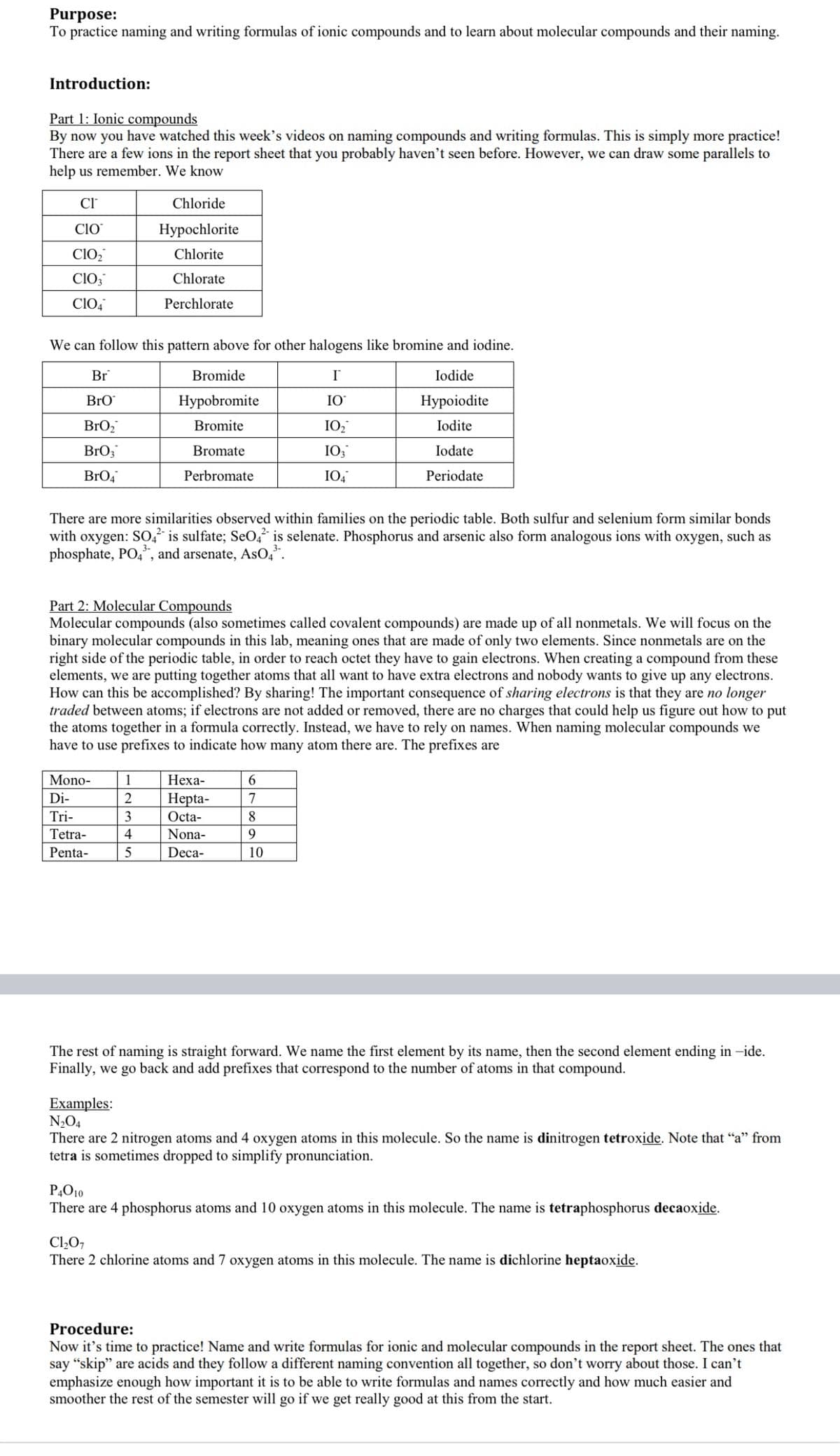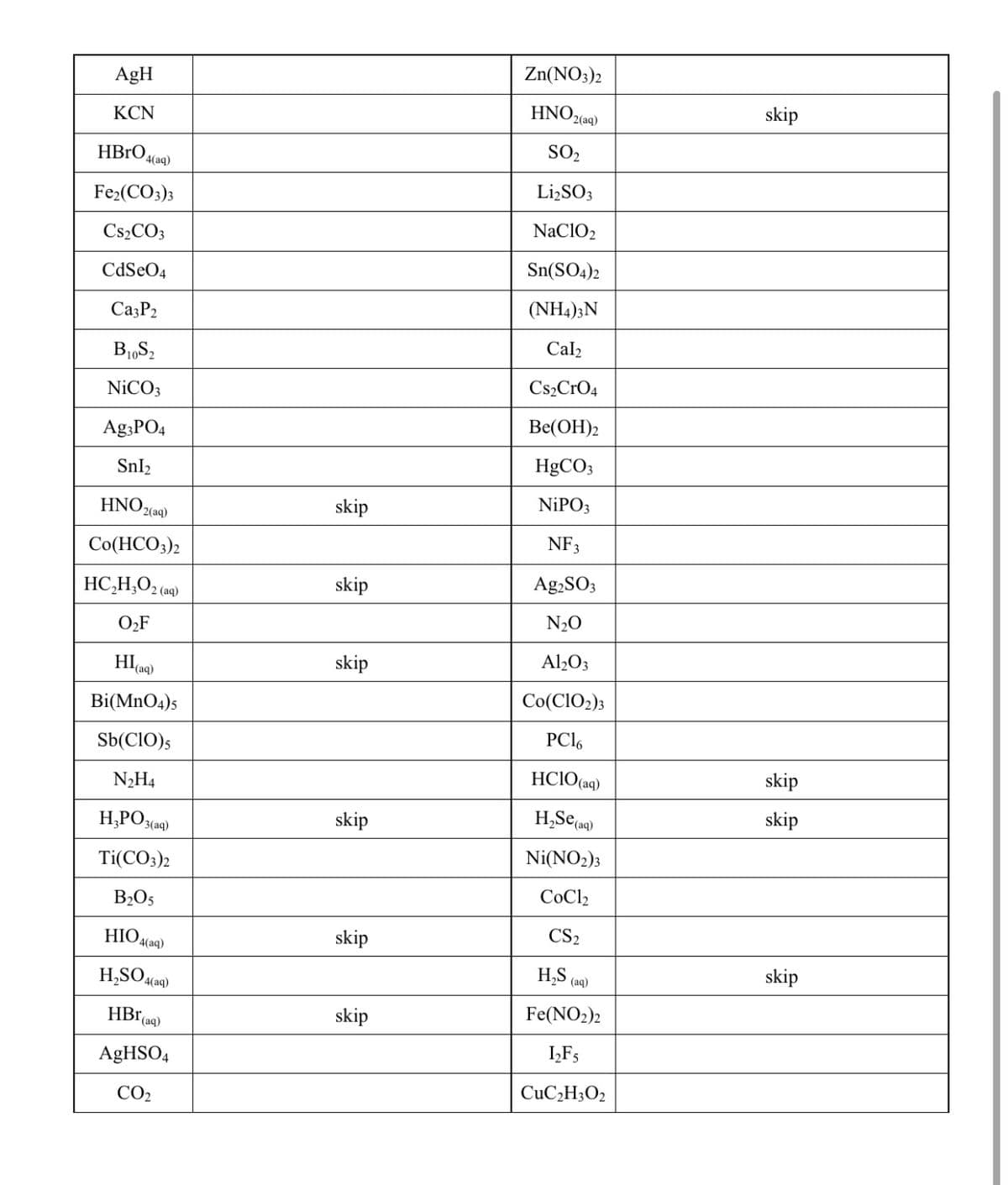Chapter4: Molecules, Compounds, And Chemical Reactions
Section: Chapter Questions
Problem 61E
Related questions
Question

Transcribed Image Text:Purpose:
To practice naming and writing formulas of ionic compounds and to learn about molecular compounds and their naming.
Introduction:
Part 1: Ionic compounds
By now you have watched this week's videos on naming compounds and writing formulas. This is simply more practice!
There are a few ions in the report sheet that you probably haven't seen before. However, we can draw some parallels to
help us remember. We know
Cl
Chloride
Clo
Нуроchlorite
Clo,
Chlorite
ClO,
Chlorate
Clo,
Perchlorate
We can follow this pattern above for other halogens like bromine and iodine.
Br
Bromide
Iodide
BrO
Нуpobromite
IO
Нуpoiodite
BrO,
Bromite
IO2
Iodite
BrO;
Bromate
IO3
Iodate
BrO4
Perbromate
IO4
Periodate
There are more similarities observed within families on the periodic table. Both sulfur and selenium form similar bonds
with oxygen: SO," is sulfate; SeO, is selenate. Phosphorus and arsenic also form analogous ions with oxygen, such as
phosphate, PO,", and arsenate, ASO,*.
Part 2: Molecular Compounds
Molecular compounds (also sometimes called covalent compounds) are made up of all nonmetals. We will focus on the
binary molecular compounds in this lab, meaning ones that are made of only two elements. Since nonmetals are on the
right side of the periodic table, in order to reach octet they have to gain electrons. When creating a compound from these
elements, we are putting together atoms that all want to have extra electrons and nobody wants to give up any electrons.
How can this be accomplished? By sharing! The important consequence of sharing electrons is that they are no longer
traded between atoms; if electrons are not added or removed, there are no charges that could help us figure out how to put
the atoms together in a formula correctly. Instead, we have to rely on names. When naming molecular compounds we
have to use prefixes to indicate how many atom there are. The prefixes are
Mono-
1
Неха-
Di-
Нepta-
7
Tri-
3
Octa-
8
Tetra-
4
Nona-
9.
Penta-
5
Deca-
10
The rest of naming is straight forward. We name the first element by its name, then the second element ending in -ide.
Finally, we go back and add prefixes that correspond to the number of atoms in that compound.
Examples:
N2O4
There are 2 nitrogen atoms and 4 oxygen atoms in this molecule. So the name is dinitrogen tetroxide. Note that "a" from
tetra is sometimes dropped to simplify pronunciation.
P,O10
There are 4 phosphorus atoms and 10 oxygen atoms in this molecule. The name is tetraphosphorus decaoxide.
Cl207
There 2 chlorine atoms and 7 oxygen atoms in this molecule. The name is dichlorine heptaoxide.
Procedure:
Now it's time to practice! Name and write formulas for ionic and molecular compounds in the report sheet. The ones that
say “skip" are acids and they follow a different naming convention all together, so don't worry about those. I can't
emphasize enough how important it is to be able to write formulas and names correctly and how much easier and
smoother the rest of the semester will go if we get really good at this from the start.

Transcribed Image Text:Zn(NO3)2
AgH
skip
KCN
2(aq)
HBrO4(aq9)
SO2
Li,SO3
Fe2(CO3)3
NaCIO2
CS2CO3
Sn(SO4)2
CdSeO4
(NH4)3N
Ca3P2
Cal2
B1,S,
Cs2CrO4
NİCO3
Be(OH)2
Ag;PO4
HgCO;
Snl2
HNO2(aq)
skip
NİPO3
NF3
Co(HCO3)2
HC,H;O2 (aq)
skip
Ag,SO3
N20
O,F
skip
Al½O3
Co(CIO2)3
Bi(MnO4)5
PC16
Sb(CIO)5
HCIO(aq)
skip
N2H4
H,PO3(aq)
skip
H,Se aq)
skip
Ni(NO2)3
Ti(CO3)2
CoCl2
B2O5
CS2
HIO4(aq)
skip
H,SO4(aq)
H,S
(аq)
skip
HBr (aq)
skip
Fe(NO2)2
IF5
AGHSO4
CuC,H3O2
CO2
Expert Solution
Step 1
Since you have posted a question with multiple sub-parts, we will solve the first three subparts for you. To get the remaining sub-part solved please repost the complete question and mention the sub-parts to be solved.
In the given question, the below-given compounds have to be named according to the provided rules:
1) AgH
2) KCN
3) HBrO4
Trending now
This is a popular solution!
Step by step
Solved in 2 steps

Knowledge Booster
Learn more about
Need a deep-dive on the concept behind this application? Look no further. Learn more about this topic, chemistry and related others by exploring similar questions and additional content below.Recommended textbooks for you


World of Chemistry, 3rd edition
Chemistry
ISBN:
9781133109655
Author:
Steven S. Zumdahl, Susan L. Zumdahl, Donald J. DeCoste
Publisher:
Brooks / Cole / Cengage Learning

Chemistry: Matter and Change
Chemistry
ISBN:
9780078746376
Author:
Dinah Zike, Laurel Dingrando, Nicholas Hainen, Cheryl Wistrom
Publisher:
Glencoe/McGraw-Hill School Pub Co


World of Chemistry, 3rd edition
Chemistry
ISBN:
9781133109655
Author:
Steven S. Zumdahl, Susan L. Zumdahl, Donald J. DeCoste
Publisher:
Brooks / Cole / Cengage Learning

Chemistry: Matter and Change
Chemistry
ISBN:
9780078746376
Author:
Dinah Zike, Laurel Dingrando, Nicholas Hainen, Cheryl Wistrom
Publisher:
Glencoe/McGraw-Hill School Pub Co


Introductory Chemistry: An Active Learning Approa…
Chemistry
ISBN:
9781305079250
Author:
Mark S. Cracolice, Ed Peters
Publisher:
Cengage Learning

Chemistry for Today: General, Organic, and Bioche…
Chemistry
ISBN:
9781305960060
Author:
Spencer L. Seager, Michael R. Slabaugh, Maren S. Hansen
Publisher:
Cengage Learning